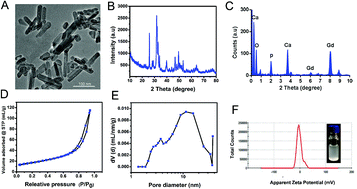An oral drug delivery system with programmed drug release and imaging properties for orthotopic colon cancer therapy†
Abstract
Oral drug delivery systems (ODDSs) have attracted considerable attention in relation to orthotopic colon cancer therapy due to certain popular advantages. Unfortunately, their clinical applications are generally limited by the side-effects caused by systemic drug exposure and poor real-time monitoring capabilities. Inspired by the characteristics of pH changes of the gastrointestinal tract (GIT) and specific enzymes secreted by the colonic microflora, we anchored polyacrylic acid (PAA) and chitosan (CS) on Gd3+-doped mesoporous hydroxyapatite nanoparticles (Gd-MHAp NPs) to realize programmed drug release and magnetic resonance imaging (MRI) at the tumor sites. In particular, the grafted PAA, as a pH-responsive switch, could effect controlled drug release in the colon. Further, CS is functionalized as the enzyme-sensitive moiety, which could be degraded by β-glycosidase in the colon. Gadolinium is a paramagnetic lanthanide element used in chelates, working as a contrast medium agent for an MRI system. Interestingly, after oral administration, CS and PAA could protect the drug-loaded nanoparticles (NPs) against variable physiological conditions in the GIT, allowing the drug to reach the colon tumor sites, preventing premature drug release. Enhanced drug concentrations at the colon tumor sites were achieved via this programmed drug release, which subsequently ameliorated the therapeutic effect. In addition, encapsulating both chemotherapeutic (5-fluorouracil, 5-FU) and targeted therapy drug (gefitinib, Gef) within Gd-MHAp NPs produced a synergistic therapeutic effect. In summary, this study demonstrated that such a novel drug system (Gd-MHAp/5-FU/Gef/CS/PAA NPs) could protect, transport, and program drug release locally within the colonic environment; further, this system exhibited a worthwhile therapeutic effect, providing a promising novel treatment strategy for orthotopic colon cancer.



 Please wait while we load your content...
Please wait while we load your content...